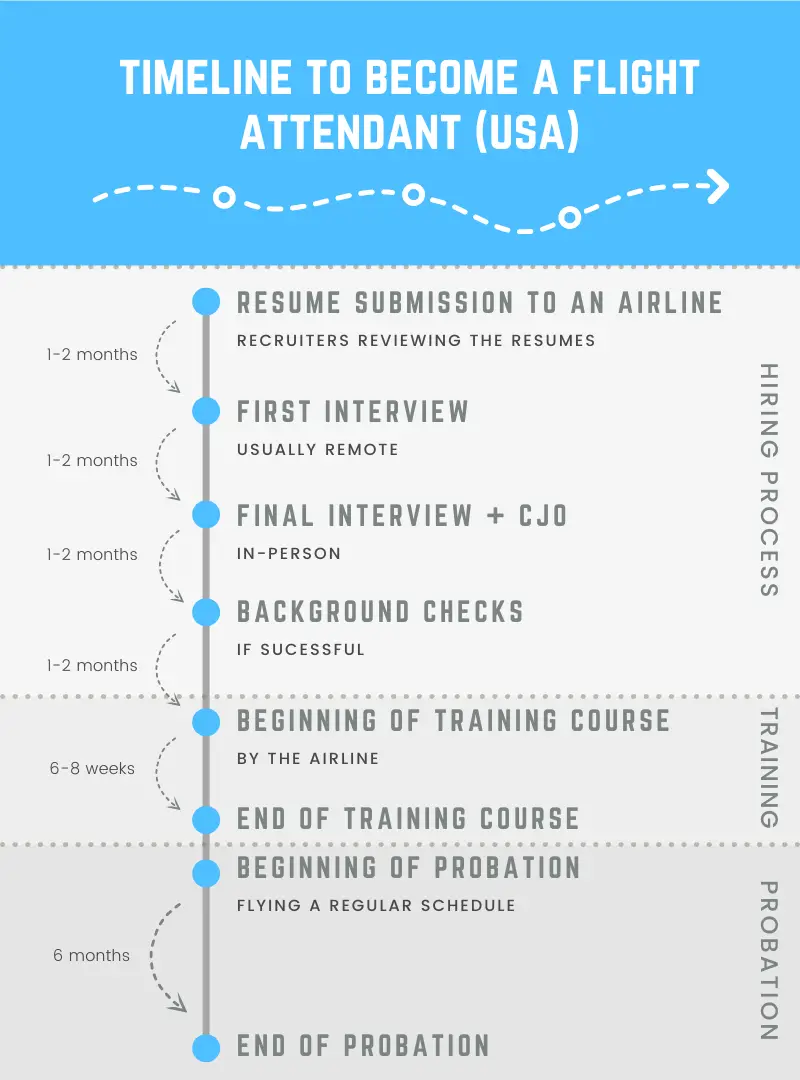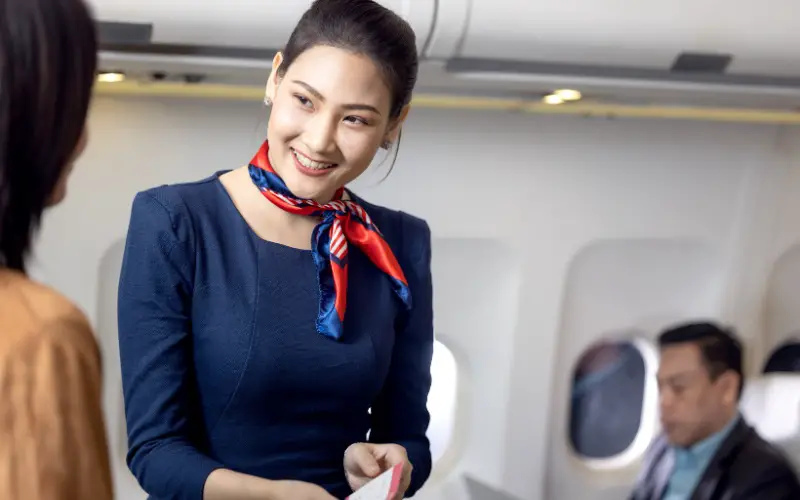When I first went through the process of becoming a flight attendant, I was shocked by how long it took. It is not a dream that can be achieved overnight.
The time it takes to become a flight attendant varies from company to company and country to country.
To spare you the shock and to help you make plans for the transition phase that comes with becoming a flight attendant, I have put together this article that briefly goes over the timeline of becoming a flight attendant.
Overview of the Process of Becoming a Flight Attendant
The process of becoming a flight attendant takes about a year on average, with the timeline being longer in some European countries and shorter in the United States.
Usually, there are three phases when it comes to the process of becoming a flight attendant.
- Hiring Process: this phase includes applying, casting days, and interviews.
- Training: this phase includes all schooling that may be required to earn your wings.
- Probation/Supernumerary Flights: this phase happens after you start flying and is a way for the company to review your performance and supervise your first flights.

Phase 1: The Hiring Process
The first step to becoming a flight attendant is getting hired by an airline. The actual hiring process will vary from airline to airline and country to country.
This phase usually lasts around 6 months.
In general the process begins when you submit your resume to the airline’s recruitment team either in-person at a casting day, or online through a hiring portal.
It can take a month or two for the recruiters to review all of the resumes they collect and invite candidates to an interview.
After the first interview, which is usually remote, it can take another month or two before you get invited to a final in-person interview.
If you are successful, you will receive a Conditional Job Offer (CJO) which is contingent on your ability to successfully complete phase two, training.
Be aware it can take a month or two for the airline to finish processing your background checks, which they need to do before they can assign you training dates, so there will be a few months between the date you get hired and the date you actually start training.
Phase 2: Training
Training processes look very different from country to country because the training requirements are usually regulated by some kind of government agency.
In the US, for example, flight attendants are only required to complete a 6–8-week course offered by airlines themselves. No prior training or schooling is required!
In some European countries, however, it is necessary to attend an independently run flight attendant school and obtain a “Cabin Crew Attestation,” certifying that you have been taught the basic knowledge required to be a flight attendant. These courses usually last 4-9 months!
Note: This is not the case if you are applying to work for Lufthansa. So not all European airlines require you to attend a school. And since these private courses tend to be very expensive ($2,000-$6,000) I would highly recommend waiting to sign up for such a course until you get a CJO from a company that requires one.
For more information on private flight attendant schools check out our article: Are Flight Attendant Schools Worth it? Pros & Cons.
After you finish the private schooling program, (when it is necessary), you are then also required to attend a shorter training program with your airline to learn that airline’s specific procedures and policies. These courses are usually an additional 2-4 weeks.
Once you have successfully completed training you will earn your wings and be able to start your job, but the process isn’t entirely over yet!
You still have phase three!
Phase 3: Probation/Supernumerary Flights
The third phase takes place after you officially start working for your airline.
But be wary, your job isn’t secure until you finish phase three, so you need to be on your best behavior.
In the United States probation lasts 6 months.
During this time you will fly a regular schedule.
Some airlines will have to complete a few additional mini-trainings during this time, with a focus on how to do international services properly, or how to bid correctly.
But most importantly, you will have random inspection rides from managers who will be watching you to make sure you are following the proper protocols and policies. If you mess up a federal protocol, or if you commit some other serious oopsie-daisy, you will be let go.
Union protections for unionized airlines in the US only kick in once you have successfully made it through probation.
In Europe, you will have supernumerary flights, for the first few weeks of your career during which you will be essentially shadowing active crews as an additional crew member. Some airlines require you to complete a number of days, flights, or flight hours before you can become a full-fledged crew member, but generally speaking you can expect to be doing supernumerary flights for 2-4 weeks.
Note: In the US the supernumerary flights exist, but they are incorporated into the training program, during which you will do 2-3 days of flying as an additional crew member.
Timeframe for Becoming a Flight Attendant
All told, the time it will take to complete all three phases described in this article is approximately 6-12 months unless you have to do a longer preparatory school course, in which case it can take up to 18 months to become a flight attendant.
Conclusion
The process of becoming a flight attendant can be quite time-consuming.
Based on the process we described above I want to leave you with a few pieces of take-away advice.
- Don’t quit your current job until you begin phase two. Otherwise, you might find yourself unemployed for a few months after receiving your CJO.
- Be patient, it takes time, but the time investment is absolutely worth it!
- Enjoy the process! And check out the many other helpful articles on our blog that will help you prepare for interviews, pack for training, and survive your first few weeks as a flight attendant!




